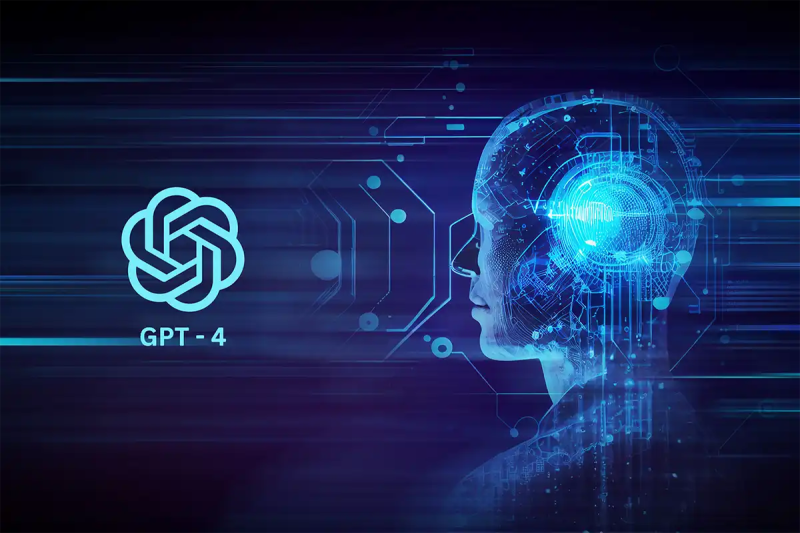OpenAI, the leading AI research company, has recently hinted at their newest generative language model called GPT-4. This model marks the latest leap forward in the capabilities of AI systems that are trained on massive datasets to perform human-like language tasks like conversing, writing, summarising, and logical reasoning.
Building upon the game-changing GPT-3 model released in 2020, GPT-4 pushes the boundaries on almost all fronts - scale, speed, contextual reasoning abilities, and precision of output control. Although full specifications of GPT-4 remain confidential for now, pieced together information indicates how this newest Large Language Model application fits into the rapidly accelerating trajectory of AI progress toward matching extensive areas of generalised human abilities.
Unparalleled Scale
GPT-4 is vastly bigger than previous models, with over 100 trillion parameters to train - over 250 times more than GPT-3. This massive scale lets it absorb patterns from an unimaginable amount of text data. This improves its ability to produce coherent, customised responses by predicting realistic sequences of text. It also enables splitting the model into specialised compartments - pre-training parts of the model on specific narrow datasets to allocate dedicated capacity for particular domains.
Multimodal Expandability
Unlike text-constrained ancestors, GPT-4 demonstrates native support for inputs and outputs spanning multiple media types, including images, charts, video, audio, and more. Dedicated encoder-decoder modules for each data type allow cross-translation and reasoning across modalities. For instance, descriptions of visual scenes identified from images, video captioning based on transcripts, generating images from detailed prompts or even full video generation with focused prompts.
Logical Reasoning
Simply having the ability to generate lots of text isn't enough for Large Language Model applications like GPT-4. They also need to be able to logically reason about the world, which previous LLM apps lacked. GPT-4 aims to improve reasoning abilities in a few key ways.
First, it has special modules dedicated to different types of reasoning, including mathematical word problems, deductive logic, scientific analysis, and breaking down arguments. To have components focused on these tasks, GPT-4 will be better at understanding and participating in complex reasoning.
Second, its training process has been updated to mix different types of data sources. This helps GPT-4 ground its knowledge and responses in factual information instead of just making things up. As a result, it should avoid some of the credibility and hallucination issues that impacted previous models.
An enhanced reasoning plus training focused on accuracy, GPT-4 is expected to have much more intelligent, grounded conversations. It should be able to answer challenging questions, explain concepts, and analyse situations without losing credibility due to gaps in its underlying logic. These improvements promise to significantly expand GPT-4's informational query and conversational capabilities compared to past language models.
Blazing Fast Adaptability
A major limitation of past large language application models has been that customising them for new users is very resource-heavy, requiring extensive retraining on new data. GPT-4 aims to fix this with vastly faster onboarding - it can grasp new concepts and rules from just a few examples, a capability called one-shot or few-shot learning. This architecture advance not only makes personalization far more accessible but also allows efficient training across many different datasets and tasks at once. Where past models struggled to adapt, GPT-4 should flexibly pick up new domains with minimal data and tweaking.
Reinforced Oversight
As AI systems become more capable, their adverse societal impacts also grow. Therefore, responsible controls are just as important as maximum performance in GPT-4. Multiple oversight measures are built into GPT-4, from filtering the initial data to moderating final outputs.
These visible improvements show GPT-4 could come closer to human-level general intelligence than previous models, across communication, information access, and critical thinking. In some use cases, its creative generation and explanation abilities approach humans. GPT-4 continues machine learning’s core goal - ingesting enough quality data and computation to extract patterns and rules that simulate domain mastery at scale.
However, while pursuing ever-higher capability, GPT-4 also demonstrates priorities around accountability and oversight to try to reduce societal risks from such powerful AI. Responsible controls attempt to match expanded competence.
The Coming Compute Arms Race
The massive increase in size from GPT-3 to GPT-4 has sparked a global hardware arms race to obtain enough computing power. Even the top supercomputers of 2021 fall short of what’s likely needed to fully train GPT-4. This is driving major AI companies like NVIDIA, Intel, Google, and Amazon and startups like Cerebras to invent custom AI chips and computing Centre’s tailored to models this large.
With AI compute demands and costs skyrocketing, access could soon bottleneck advanced research if the hardware capacity race continues exponentially. Packing more performance per silicon chip has become intensely competitive as GPT-4 points toward a future of models requiring computing on a mammoth, unprecedented scale.
Energy Drain Compounds Climate Impact
The exploding size of large language model app like GPT-4 also drastically increases the environmental impact of AI research. GPT-3 was estimated to produce the lifetime carbon emissions of 5 cars - now dwarfed by GPT-4's needs. While companies talk about using renewable energy and optimization, demand growth keeps outstripping these efforts.
Critics are calling for governments to mandate carbon labelling of AI systems - from data collection through production - to track their true environmental toll. Even AI leaders striving to improve have struggled with emissions skyrocketing. Rapid green progress seems necessary to counterbalance AI's surging computing scale and answer doubts around industry environmental claims.
Economic Ripple Effects
GPT-4 could disrupt global economics much like previous versions. As GPT-3 demonstrated, business applications using text and content span countless industries - from healthcare to education and policymaking. Investments and startups utilising language models are surging across sectors. However, the hardware processing power required for ever-larger models risks pricing out smaller companies. The computational demands of advanced systems like GPT-4 may determine who can and cannot afford to compete in using rapid AI progress. So, industry access concentration emerges as a key concern alongside the tech's transformative economic capability.
The Talent Squeeze Intensifies
Shortages of AI talent have hit record highs in recent years, intensifying with each innovation like GPT-4. Generative AI advances are compounding recruitment challenges across the industry. Frameworks evolve rapidly, while PhDs with applied machine learning experience remain extremely scarce. Top teams can take 6-12 months to get up to speed on new architectures like GPT-4. The pace of change accelerating, and some argue engineering education itself needs to adapt. Opportunity costs mount since few possess the latest skills. The AI skills gap slows progress as organisations strain to onboard rare expertise into novel frameworks like generative language.
Monitoring for Misuse Hazards
As language models like GPT-4 become more capable, their capability for societal harm also increases if misused. GPT-3 enabled applications that produced toxic text, phishing scams, and disinformation. Despite internal oversight measures built into GPT-4, additional governance would be needed to address emerging threats. Suggested safeguards include third-party audits, bias bounties to find problems, testing for vulnerabilities, and gradual public access. The extremely powerful generative abilities of GPT-4 will require diligent efforts both within OpenAI and externally across languages and regions to mitigate and prevent abusive applications as much as possible. Careful precautions should aim to match the advanced capabilities coming with systems progressing toward human levels of language proficiency over time.
Weighing Near-Term Benefits
Despite legitimate concerns, excitement is high in many industries like healthcare and education about the benefits of GPT-4. Existing use cases show promise for lightening workloads in areas like content creation, personalised instruction, and medical analysis. Some may argue such beneficial domains should get early access for responsible adoption ahead of the general public. Some suggest openly sharing scaled-down intermediate models. These would offer partial gains without the full risks of industrial-scale systems nearing human capability across all applications. Prioritised access and staged model releases could ensure GPT-4 aids sectors like medicine and academics before reaching widespread circulation.
Is Stronger AI Inevitable?
GPT-4 sparks broader debates around not just this model, but the inevitability of AI one-day matching or surpassing human intelligence, known as AGI. The steady progress from GPT-3 to GPT-4 shows that given enough data, computing power, and design iterations, algorithms can learn more and more facets of reasoning, knowledge, and language. Each version improves upon the last, filling gaps. If these trends continue, the data and energy demand to replicate all neural connections in the human brain appear increasingly achievable, not distant - seemingly an optimization challenge given enough scale. So, while discussions center on GPT-4 specifics now, they ultimately raise deeper questions about machines destined to meet and exceed the full spectrum of biological cognition.
And So, We Forge Ahead
GPT-4 represents the latest leap at the frontier of the AI revolution which is enabled by engineering creativity, business investment, and academic research spanning decades. As the most advanced language model to date, it will be in progress on the capabilities and applications but also raise crucial questions around ethics, access, and security.
Its success depends on both enabling productivity gains and establishing responsible guardrails. The next iteration likely already looms - with expanded abilities and challenges alike. GPT-4 arrives at an exciting yet delicate phase - realising technological breakthroughs that fascinate many, but require thoughtful oversight to manage emerging risks.
The accelerating progress makes AI seem perpetually a dual-edged sword: The most promising benefits for society, while also introducing complex concerns around monitoring systems rapidly exceeding human aptitudes on more and more fronts.









